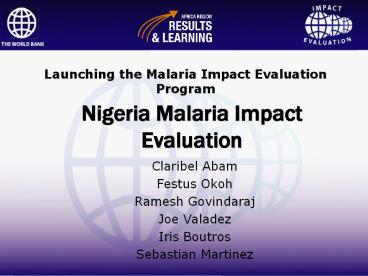Nigeria Malaria Impact Evaluation - PowerPoint PPT Presentation
1 / 11
Title:
Nigeria Malaria Impact Evaluation
Description:
Mid-May expenses for videoconference meeting (1 day, domestic travel for 15 people) ... August workshop (5 days, domestic travel for 15 people, venue, etc) ... – PowerPoint PPT presentation
Number of Views:41
Avg rating:3.0/5.0
Title: Nigeria Malaria Impact Evaluation
1
Nigeria Malaria Impact Evaluation
Launching the Malaria Impact Evaluation Program
- Claribel Abam
- Festus Okoh
- Ramesh Govindaraj
- Joe Valadez
- Iris Boutros
- Sebastian Martinez
2
Intervention
- Scale up of the coverage and use of LLITNs, ACT,
IPT and IRS in seven program states - Innovative demand and supply side approaches,
with the objective of reaching 80 use of ITNs by
vulnerable group by 2010. - The impact evaluation design was focused on two
areas of primary importance - Delivery of LLITNs and ACT through private sector
- Ways of improving the implementation and
performance of the alternative delivery
mechanisms. - Ways of improving coverage and use of LLITNs and
ACT on the demand side - Focus on
- PMV (Patent Medicine Vendors)
- RMM (Role Model Mothers) /TBA (Traditional Birth
Assistant) - CHW (Community Health Worker) /VHW (Village
Health Worker)
3
Supply Side Policy Questions
- National Level (7 program states)
- What is the effect of delivery of LLITNs and ACT
through the private sector (PMVs) on coverage and
usage of LLITNs and effective anti-malarial
treatment? - Pilot Schemes
- What is the marginal effect of alternative
incentive schemes on the performance of PMVs? - What is the marginal effect of follow-up/ongoing
training on the performance of PMVs?
4
Demand Side Policy Questions
- National Level (7 program states)
- What is the effect of Role Model Mothers (RMM)
on the coverage/use of LLITNs and effective
anti-malarial treatment? - Pilot Schemes
- What is the effect of alternative incentive
schemes to RMMs, TBAs and CHWs on the coverage
and usage of LLITNs and effective anti-malarial
treatment? - What is the effect of follow-up/ongoing training
to RMMs, TBAs and CHWs on the coverage and usage
of LLITNs and effective anti-malarial treatment?
5
Indicators
- coverage of LLITNs
- use of LLITNs
- use of ACTs
- fever
- other maternal and child health outcomes
- socio-economic outcomes (labor supply,
income/consumption, schooling, etc)
6
Evaluation Design - National
- Incorporation of PMVs and RMM through LGA level
training activities over a 9-12 month period. - Random roll out of training activities amongst
LGAs across 7 project states - Exogenous variation in the presence of PMVs/RMM
(6-9 month exposure) - Exogenous variation in exposure to treatment
thereafter - LGAs trained first constitute the treatment group
- LGAs trained last constitute the control group.
- Consider opportunities for randomizing at Ward
level. - Roll out of training activities commence by June
2007.
7
Evaluation Design Pilot Studies
- Representative sample of evaluation communities
or villages - Random assignment of incentives to PMVs
- Random assignment of training to PMVs
- Random assignment of incentives to RMMs/TBAs/CHWs
- Random assignment of training to RMMs/TBAs/CHWs
- Unit of randomization likely to be the community
or village
8
Sample and Data
- National
- LQAS Monitoring data
- 62 LGAs in 7 states
- Baseline already conducted in late 2006
- Follow up in early/mid 2008
- Power calculations needed to determine detectable
effect size - Pilot
- Primary household level data on representative
sample of communities - Sample sizes to be determined
9
Staffing Plan
- Impact Evaluation Team
- Impact evaluation experts (World Bank/IFS)
- Country team (National/State/LGA Malaria
Programs) - Local Academics
- Data Collection (National Bureau of Statistics
NBS)
10
Timeline
- Short Run Activities
- Mid-May technical work to randomize roll out of
LGAs (training of PMVs) followed by a
videoconference - June Workshop in Abuja for planning of national
impact evaluation - August Country level workshop for ME and IE for
planning of pilot impact evaluations
11
Budget
- Short run expenses
- Mid-May expenses for videoconference meeting (1
day, domestic travel for 15 people) - Expenses for training in June (6 days, domestic
travel for 15 people) - August workshop (5 days, domestic travel for 15
people, venue, etc) - Budget TBD, aprox 100,000 for initial activities































